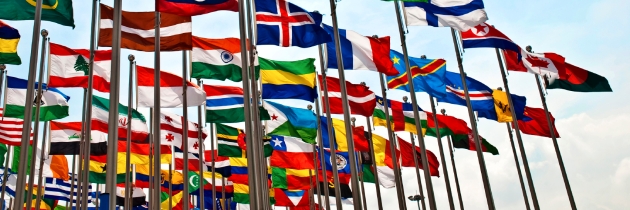Blogs

Avantpage Translators: 3 Quick Facts
1. Who Are Avantpage's Translators? At Avantpage, our translators are the lifeblood of our company. Their skills, knowledge, and expertise enable us to provide accurate, quality translation in well over 150 languages for a diverse client base, including healthcare, financial, education, government and more. At Avantpage, our translators are much more than just foreign language experts. They have a passion for linguistics, a gift for understanding the finer points of syntax, grammar, and style, and a profound knowledge of how language and culture affects written and oral communication, beliefs, and behaviors. 2. How Are Translators Selected? We select our translators very carefully, and they must go through a rigorous qualification/training process before being asked to join the Avantpage team. We choose individuals based on their depth of knowledge, experience, and professionalism, and offer complete training on our online project management systems, translation tools, quality control processes, company expectations, and specific customer service guidelines. 3. What Can You Expect? When you choose Avantpage for your translation needs, you can rest assured you will be working with the best translators in the business - experienced, focused, expert, individuals who put their heart and soul into every translation project they take on. To find out more about Avantpage's translators, call 877-ANY-LANG or email [email protected] today!

Advanced translation technology puts a trio of powerful tools at your fingertips – AvantFlow, AvantMemory, AvantForum
By tapping into next generation web-based technologies, Avantpage has increased our online capabilities and streamlined our translation processes. Navigation, customization, communication - it's all easier, faster, and more efficient than ever before. We've designed three powerful software applications - AvantFlow, AvantMemory, and AvantForum - to work cohesively and provide a more productive, user-friendly online translation environment. What can you expect to gain from putting these tools to use? For starters, you'll have greater control over all your translation projects, from initial quote to final delivery. You'll gain instant online access to all aspects of a project's progress, which makes monitoring and tracking that much easier. These tools give you the freedom to spend less time on administrative tasks, troubleshooting and backtracking - and more time overseeing the quality, accuracy, consistency and timelines of the projects themselves. AvantFlow allows you to manage, organize, and keep track of all your translation projects AvantFlow is our signature online project management system, now upgraded and revised to be more practical and accessible than ever before. Easier site navigation, improved access to resources and faster response times are just some of the latest improvements. Use AvantFlow to request quotes, instantly check project status, give detailed project instructions, upload source files, assign due dates and deadlines, and much more. AvantMemory lets you access and manage your translation assets more easily and effectively AvantMemory is a web-based system that streamlines the translation process, providing greater client control. AvantMemory includes customized linguistic glossaries that save specific terminology and style preferences; allows multiple vendors to work with the same assets in real time; allows linguistic team members to work concurrently; and lets work on a project proceed with multiple languages simultaneously. AvantForum facilitates communication and collaboration in real time between project stakeholders Through AvantForum, all communication relating to a specific project is captured in one central online location. All project stakeholders have instant access to the same information, including preferences and requirements, online conversations, emails, meeting notes and more. AvantForum minimizes the possibility of critical information "slipping through the cracks," while maximizing client/translation team collaboration and effectiveness. Through the use of these next generation technologies, we'll be able to focus all of our efforts on providing exceptional translation and language services. And you will be able to keep your translation projects moving forward smoothly - on target, on time and under budget. Call us today for a free demo of any of these technologies at 877-ANY-LANG or [email protected].

Avantpage Partners with XTM International to Market and Distribute XTM Cloud Solutions to North and Central America
Avantpage has agreed to act as a non-exclusive agent for sales of XTM Cloud computing solutions to companies and organizations in North and Central America. Avantpage is pleased to have this opportunity to work with XTM International to reach new markets. Click here for more information.

New Case Study: AvantMemory
Avantpage recently utilized XTM International's AvantMemory product to deliver a crucial, high quality job - on time and within budget, without compromising on quality. Read the full case study here, and learn how Avantpage served its large health care client with a 30-file, Spanish-to-English translation project, totalling one million words -- and only 9 days to complete the project. This new case study details the task, key questions, and outcome of this project. You may also contact Avantpage at (530) 750-2040 or at [email protected] for more information.

Avantpage Partners with the Davis Bridge Foundation to Promote Educational Success
The Davis Bridge Educational Foundation is an organization devoted to promoting educational opportunities for all Davis, California students, regardless of income level, race, or ethnicity. The Davis Bridge works with low-income, under-achieving Davis students in grades K-12. The majority of students in Davis who fit this description are Chicana/o Latina/o students. However, the Bridge serves Anglo, Asian, East Asian, and African/African-American children as well. Bridge volunteers provide tutoring, computer access, school supplies, and after-school snacks to students at four after-school homework clubs in the Davis area. The Davis Bridge Foundation hopes to make college and academic success a realistic goal for these children by making them feel valued, showing them they have the power to achieve, and giving them the academic tools and support system to do so. Avantpage and CEO Dr. Luis Miguel have been involved with the Davis Bridge Foundation since 2004, offering IT support, website design/hosting and email support. Avantpage provides all Spanish translations for the Bridge, and has donated several computer systems to them as well. In addition, Dr. Miguel was President of the Davis Bridge Foundation Board from 2004 to 2010. The Davis Bridge is a cause close to Dr. Miguel's heart, and he believes that local initiatives such as the Davis Bridge can have a significant impact on communities and their members. According to Dr. Miguel, "I see education, and all it carries with it, as the most important determinant of success for young people. My kids are just like many of the kids served by the Davis Bridge, with education being the main differentiator." To find out more about Davis Bridge, its mission, and how you can contribute, go to www.davisbridge.org or contact Janet Boulware, Executive Director and Founder, by e-mail at [email protected] or call (530) 574-2804.

Cultural Connection — Filipino American
As a translation company, we work closely with many different ethnic groups. In this new series, we'd like you to join us as we take a closer look at some of these groups residing in the United States. We'll focus on a different group each month, and briefly explore their culture, languages and demographics. To kick off our series, we'd like to start with Filipino Americans. Filipino Americans are the second-largest Asian American group in the United States, with 3.1 million individuals residing here, according to the 2007 American Community Survey conducted by the U.S. Census. Hawaii, California, New York, New Jersey, Washington, Illinois, Texas , Florida, Virginia and Nevada are the states with the largest Filipino populations. While some Filipinos emigrated to the United States seeking political freedom, many more came hoping to establish a better life with more opportunities for themselves and their families. Filipino Americans may speak Tagalog, Ilokano, Spanish, Kapampangan, Pangasinan, Visayan languages, Bikolano, and other Philippine languages at home. However, because English is one of the Philippines' official languages, many Filipino Americans are fluent English-speakers as well. In the Philippines, English is used in the legal system as well as in higher education. Filipino, based on Tagalog, is the other official standardized language of the Philippines. In the United States, Tagalog is the fifth most-spoken language, with over 1.2 million speakers. Fluency in the languages of the Philippines has declined with second and third-generation Filipino Americans, creating a language barrier between older and younger generations. Filipino Americans tend to have a strong median household income. Many have gravitated towards the healthcare industry, working as nurses, doctors, dentists and healthcare support staff. Filipino Americans have a high educational attainment rate, with 47.9% of all Filipino Americans over the age of 25 possessing a Bachelor's degree. Filipino Americans enjoy a strong sense of family and community. Festivals and community events celebrating Filipino culture are extremely important to Filipino Americans, with fiestas, street festivals, parades and feasts bringing generations together to celebrate their heritage and culture.

Language Spotlight: Khmer
This month's Language Spotlight focuses on Khmer. We've been getting more requests for this language lately, and we thought it would be an interesting language to explore in more detail. Khmer is the official language of Cambodia. It is the second most widely spoken Austroasiatic language spoken after Vietnamese. Khmer is spoken in Cambodia, Vietnam, Thailand, the United States, France and Australia. There are a total of about 8 million Khmer speakers worldwide, and in the United States, there are an estimated 190,000 Khmer speakers. The Khmer language is written in Khmer script, using the Khmer alphabet, which closely resembles the Thai and Lao alphabets. There are also influences from Sanskrit, Pali, French and Chinese in the Khmer language. The Khmer script has symbols for 33 consonants, 24 dependent vowels, 12 independent vowels and several diacritic symbols. Many words have more than one accepted spelling. There are no spaces between words in the written language, only at the end of sentences or phrases. The history of modern Cambodia is a tumultuous one. In 1887 Cambodia became part of French Indochina, but following Japanese occupation during WWII, Cambodia gained full independence from France in 1953. In 1975, Communist Khmer Rouge forces captured Phnom Penh and at least 1.5 million Cambodians died of execution, forced hardships or starvation under the new regime headed by Pol Pot. In 1978, the Vietnamese invaded and drove the Khmer Rouge into the countryside. This began a 10-year Vietnamese occupation, and touched off 13 years of civil war. The 1991 Paris Peace Accords sought to establish democratic elections and a ceasefire, but it was not until 1999 that Khmer Rouge forces surrendered. Today, Cambodia's government is a multiparty democracy under a constitutional monarchy, and national elections are generally peaceful. Cambodia's two main economic forces are textiles and tourism. This beautiful, lush country is rich with stunning ancient temple ruins, picturesque villages, seaside resorts, architecturally dazzling cities and gorgeous natural beauty. Tourism is growing, and many foreigners have made Cambodia an exciting and unusual travel destination. Avantpage's Khmer translation experts are fully equipped to provide clients with high-quality, expert translation for a variety of needs - healthcare, government, financial and more. For information about Khmer/Cambodian translation, click here.

What Do We Mean by “Quality” in Translation?
You may have heard us talk about the exceptional quality of our translation work. What does "quality" mean when talking about translation? Don't other companies provide quality as well? What sets Avantpage apart? Over the years, we've built a stellar industry reputation on maintaining excellence of quality in every translation we provide. Quality of translation means much more than translating words or sentences correctly. High quality translation is intuitive, it is accurate, it seamlessly adjusts for reading levels, and it addresses individual client and language requirements. Avantpage translation is always accurate, culturally sensitive and audience-appropriate. The reading level of the audience being translated for plays a critical part in the quality of the translation. Avantpage translators are extremely sensitive to this, and even when translating difficult medical terminology, complex financial data or legal documentation, they maintain strict adherence to the reading level of their audience. Avantpage translators accommodate reading levels from elementary school through high school/college, and are well-versed in choosing the proper wording, sentence structure and terminology that will best serve their readers' needs. Avantpage creates meticulous style guides and glossaries for clients to further enhance the accuracy, consistency and high quality of the translations. Style guides let translators know the linguistic and stylistic preferences of the audience they are translating for, and glossaries provide important terms and their preferred translations for each client. At Avantpage, our commitment to quality encompasses consistency, accuracy, linguistic excellence, the knowledge and expertise of our translation teams, and the processes and procedures we follow to ensure exceptional service. Providing quality to our clients is our number one priority, day in and day out!

Is Your Business Ready for Localization?
Localization is the process through which businesses customize their products, services and Internet presence to reflect differences in distinct markets - for example, when branching out to reach non-English-speaking or international markets. Localization involves much more than just translation. Graphic design, use of color, currency, symbols, writing style and cultural references are just a few examples of elements that come into play when preparing to localize. Why localize? In today's marketplace, the better question would be "why not?" As global markets grows ever more accessible, and more non-English speakers gain buying power and online acumen, localization represents the future of successful businesses. Localizing your online business presence allows you to tap into previously inaccessible markets, shows that you are culturally and ethically sensitive to customer needs, and gives you a leg up on your competitors. Localization also polishes your corporate image, and increases your visibility as a trusted provider of products and services. Avantpage specializes in helping businesses develop and execute a localization strategy that reflects their specific needs, markets and products. For more information on how Avantpage can help you localize your website, download our new localization guide, AvantWeb: Essentials of Web Localization. Inside, you'll discover answers to all your questions about the localization process: how it works, what's involved, what you need to provide, and how the workflow will proceed. To find out more about localization and how Avantpage can help, call 877-ANY-LANG or email today!

In the Health Care Industry, Language Barriers Endanger Patient Health
There are approximately 47 million people in the United States who speak a language other than English. Effective communication is critical to safe, quality health care, yet many health care organizations fall short when it comes to caring for Limited English Proficient (LEP) patients. According to a study conducted by the International Journal for Quality in Health Care, language barriers in hospitals were shown to increase risks to patient safety. Data was collected on adverse events affecting both LEP and English-speaking patients. The study showed that when adverse events were tracked in both groups, 49.1% of those experienced by LEP patients involved physical harm, while only 29.5% of adverse events experienced by English-speaking patients did. Of the patients who experienced physical harm, 46.8 % of LEP patients were rated at levels of "moderate temporary harm to death" while only 24.4% of the English speakers had the same harm ratings. 52.4% of the LEP patients' adverse events were related to communication errors, while 35.9% of the English speakers were communication-related. To rectify this situation, the Joint Commission has created new communication and language standards for health care organizations that will go into effect in January 2011. Hospitals seeking accreditation will need to comply with these new standards, which include providing proficient in-person or phone interpreters; ensuring that written documentation (forms, instructions, signage, etc.) is properly translated into appropriate languages; and that caregivers and health professionals are trained in culturally sensitive communication among different ethnic groups. To find out more about the Joint Commission and the standards, call 877-ANY-LANG or email today!

New "Hidden" Language Discovered in India
Last month, I read a fascinating article in The New York Times* about the discovery of a new language, spoken by a remote group of about 1,000 people in India. There are approximately 7,000 recorded languages in the world, yet many are rapidly disappearing. On an expedition to record and preserve endangered languages, a team of linguists traveled to a remote area of Northeastern India, in the foothills of the Himalayan Mountains. They were interested in the Aka language, spoken by approximately 6 to 10 thousand tribal villagers. These people live near the borders of China, Tibet and Burma, and subsist on hunting and farming, raising pigs and growing rice and barley. Small villages consist of bamboo houses set on stilts. In the tiny mountain village of Kichang, the linguists heard villagers speaking a language that did not sound like Aka. The new language was Koro, with words, syntax and sounds that were entirely different from Aka. Although the Koro speakers live in close proximity to the Aka speakers, they had a completely different language, which had never before been recorded or identified. Researchers are not entirely sure how Koro has survived as a language, as its speakers presently number only about 800 to 1,000. Why is it important to preserve languages that are in danger of becoming "extinct"? Why should we attempt to document and recognize them, when they are spoken by so few people? Language represents a people's history, its culture, its place in the world, and sometimes, its future. It is critical that these languages are preserved, recorded, and studied, for understanding a culture's language is how we eventually understand the people as well ... how they think, how they behave, how their society is structured, how they use and process information. By documenting and attempting to understand threatened languages, we can explore a small glimpse of living history. * "Hunting One Language, Stumbling Upon Another" John Noble Wilford, The New York Times, October 11, 2010

What Is the Difference Between Traditional Chinese and Simplified Chinese Text?
There are over 1 billion people in the world who speak some form of Chinese. The most popular Chinese spoken languages are Mandarin (the official language of the People's Republic of China and the Republic of China), Cantonese, Wu, and Min. No matter what spoken language or dialect is used, the Chinese have only two systems to represent their language in written form. Traditional Chinese and Simplified Chinese are the two writing systems used by those who read, write and speak Chinese. Because of cultural, historical and political reasons, written text in China evolved into two different and separate writing methods. While both writing systems share the same grammatical structure and are essentially the same language, they are not interchangeable. Traditional Chinese has been in use since the 5th century, A.D. It uses about 13,000 characters, and some of them are highly complex. Because Traditional Chinese was so difficult to learn, many, many Chinese remained illiterate. The Simplified Chinese writing system, which uses about 8,000 simplified characters, was introduced by the Chinese government as an official writing language in 1949 in order to combat the problem of illiteracy in China. Simplified Chinese text has fewer strokes per character and fewer characters in use. It is easier to write and understand. Simplified Chinese is used in mainland China and Singapore, and Traditional Chinese is used primarily in Hong Kong, Taiwan, and among the Chinese speaking population of Malaysia. Chinese speakers in the United States generally use Traditional Chinese as well. Although Traditional Chinese is more complicated, it allows for more precise pronunciation, and more distinctiveness and legibility between characters. When translating documents into Chinese, translators must be aware of which system their audience uses, and sometimes must translate the document into both. Here are some examples of Traditional Chinese characters in black, and their simplified counterparts in red*: *Omniglot.com, The Guide to Languages, Alphabets and Other Writing Systems